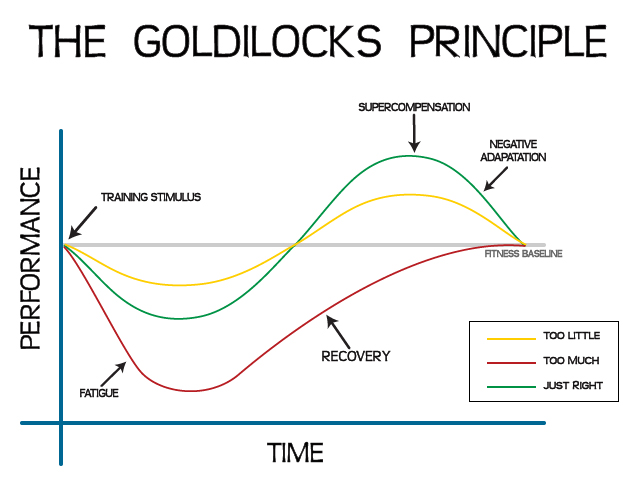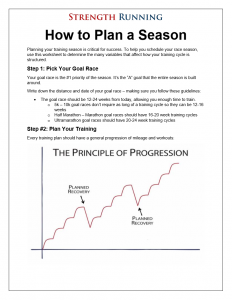Your weekly running mileage is one of the most important aspects of training to track over time. If there’s one training metric that predicts performance, it’s your total weekly volume.

When it comes to weekly mileage, there are a few truths we all must understand:
- More is generally better
- Mileage increases must be gradual to allow for adaptation
- The 10% Rule is flawed
Whenever I’ve made a conscious effort to run more weekly mileage (in a safe, strategic, methodical way), my performances have gotten substantially better:
Before I ran my last season of high school cross country, my base training was 15-25 miles more per week than prior seasons. I went on to place 3rd in our conference and run 30+ seconds faster in the 5k.
A year later, I ran another 20 miles more per week before my first collegiate cross country season. My 5k pace became my 8k pace.
And many of Strength Running’s most powerful success stories are due to higher mileage.
So, can we make it possible to run more miles?
Importantly, can we increase our weekly running mileage without getting hurt?
And can we be more strategic than blindly following the 10% Rule?
The answers are all YES! And everything hinges on a concept called “Baseline Mileage.”
What is Baseline Mileage?
First, do you know if you’re running a lot or a little? While we shouldn’t fall into the comparison trap, it can be helpful to know if you’re running low, average, or high mileage. This helps you better plan your training for the future.
Watch one of our latest videos to see a breakdown of what’s considered “normal” mileage at different levels of running:
Once you understand your current mileage levels, you can figure out your baseline.
Baseline mileage is a simple concept. Your “baseline” is whatever mileage level that you’re comfortable running before you become more fatigued, sore, or mentally tired.
Every runner has a certain number of miles that are relatively easy to run per week. It’s not a struggle to run your baseline mileage – you could theoretically run this amount week after week and still feel great.
The most effective way of determining your baseline mileage is to review the last 6-12 months of training. Ask yourself a few questions:
- Where do you feel comfortable?
- At what level do you transition from feeling great to feeling fatigued and sore from all the miles you’re running?
- At what mileage number do you start to feeling mentally burdened or intimidated?
Your baseline will be the highest number of miles that you can run comfortably without feeling mentally burdened, overly sore, or excessively fatigued.
And it’s usually not a specific number, but rather a range. For me personally, when I was at my running peak I was comfortable running 60-70 miles per week.
That was my “baseline” and I increased my weekly running mileage to 80-90 when I was training hard for a race. Any more than 90 mpw, though, and I usually got hurt.
That’s why I capped my weekly volume at that level (and did a lot of cross-training).
How to Use Baseline Mileage in Training

Weekly running mileage increases should be juuuust right
Your baseline weekly running mileage number is your starting point that influences the type of training plan you’ll choose for an upcoming goal race.
Most seasons should start under your baseline mileage and progress upward. While you don’t need to reach a weekly running mileage PR every season, it’s a valuable strategy for improvement. Remember: more is more!
If you’re not sure how to set up a week of training, this video tutorial will help:
You can also use baseline mileage to plan a more strategic season:
- Marathoners can plan backwards from race day to their current long run distance. If it’s not safe to increase your long run to about 20 miles in the time that you have, it’s time to pick a race further in the future to give yourself enough time to train.
- Half marathoners can employ a similar strategy, giving themselves enough time to reach a bare minimum long run distance of 10 miles
- Runners training for shorter distances don’t have as many constraints, but should still allow themselves time to train at weekly running mileage levels higher than their baseline, while allowing enough time for a coherent workout progression.
And once you’re training, the concept of baseline mileage is particularly helpful because it tells you how quickly you can increase your weekly volume.
If you’re running less than your baseline total, you can boost your mileage by more than 10% per week.
After all, you’re running less than an easy, comfortable mileage level. At this point in your training, you can afford to be more aggressive than the standard 10% Rule (see below).
If you’re running more than your baseline total, you can add mileage by less than 10% per week.
Since you’re running an amount that leaves you more fatigued, we ought to be more conservative than adding 10% more mileage per week.
What I love about this baseline mileage concept is that it adds complexity to the traditional 10% Rule. Training is rarely as simple as adding a certain number of miles per week and this accounts for that complexity.
Why Is the 10% Rule Flawed?
Knowing your baseline mileage helps with consistency!
The 10% Rule is a common way of figuring out how much volume to add to your weekly running mileage. It’s generally considered safe to add no more than 10% of your weekly mileage from week to week.
But this “rule” is highly flawed. It completely breaks down in both very low and high mileage situations.
Consider a runner who’s comfortable running about 30 miles per week. If this person takes a week off after a goal race, how can they build their mileage back up to 30 miles per week?
Well, the first week might include only 3 short, easy runs for a total of 15 miles (say, a 3 miler, a 5 miler, and a 7 miler). Should the next week increase by 10% to 16.5 miles?
Of course not!
That increase is too little. Your body will barely notice the difference when we’re discussing increases as low as 1-3 miles.
Instead, this hypothetical runner could run weekly running mileage totals like this:
- Week 1: 15 miles in 3 runs
- Week 2: 25 miles in 4 runs (a 67% increase from the last week)
- Week 3: 30 miles in 4 runs (a 20% increase from the last week)
This schedule looks aggressive but it won’t feel challenging. And it’s a much more productive way to run higher mileage.
But on the other end of the spectrum, we can see how the 10% Rule is far too aggressive once you’re beyond your baseline mileage.
Remember: this is uncharted territory. This is when you’re tired, sore, and fatigued. Running is a much bigger stress once you’re pushing yourself beyond your comfortable weekly running mileage.
If your baseline is 40 miles per week, you don’t want to run 44 miles the next week, and then 48, and then 53. It’s exactly this type of poorly structured training that leads to injuries.
We cover this in one of our Q&A videos on YouTube:
Instead, be more conservative beyond your baseline mileage. Add 5-10% more mileage every other week or follow a similar, less aggressive strategy.
Smaller increases – spread over a longer time period – give your body enough time to recover, adapt, and prepare for your next big workout. They enable you to stay healthy while also building your capacity to run more.
Better Planning = Faster Racing
Ultimately, this article isn’t about weekly running mileage or your baseline volume. It’s not about how to increase your mileage or how to do that safely with fewer injuries.
It’s really about planning.
When you understand what your body is capable of – and what it’s not – you can be more strategic and methodical about how your training is structured.
You’ll give yourself enough time to train properly for whatever distance you’re preparing for.
Aggressive mileage increases will be more rare – and so will your injuries.
And race performances will improve because training has improved!
Better planning always leads to better performances – like one of my custom training plan clients:
“Just ran my goal race and hit the 9:00 min/mile goal! The biggest victory, though, is that my training has changed significantly since starting the program.
I am running the most consistent mileage I ever have in my life. I now know how to structure a workout and a program by myself. After seeing what I can do in 14 weeks, I’m motivated to run longer and faster.” – Stephanie
As you start setting up your race schedule and preparing for the next training cycle, I want to give you even more resources to do that as effectively as possible:
- How to Prevent Running Injuries (SR’s big resource page on the topic of injury prevention / treatment)
- Marathon training mileage recommendations
- [Video] Planning a Season
- How to Structure Weekly Mileage (depending on how much you’re running)
- Marathon Long Runs: How far and how fast?
One of our most helpful resources is the free Season Planner Worksheet to help you do this on your own.
It includes highlights from the video above, plus:
- Example tune-up race scheduling
- The best tune-up race distances for 5k – marathon goal races
- The 3 ingredients to a successful season, no matter the race goal
I want to make your next race a HUGE personal best.
It all starts with a good plan, so make sure you sign up to get your free Season Planner Worksheet.